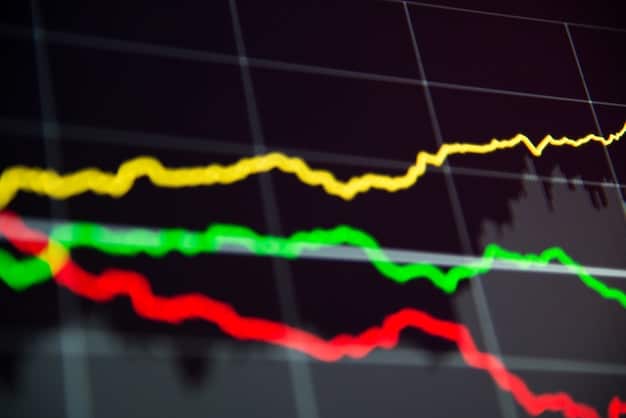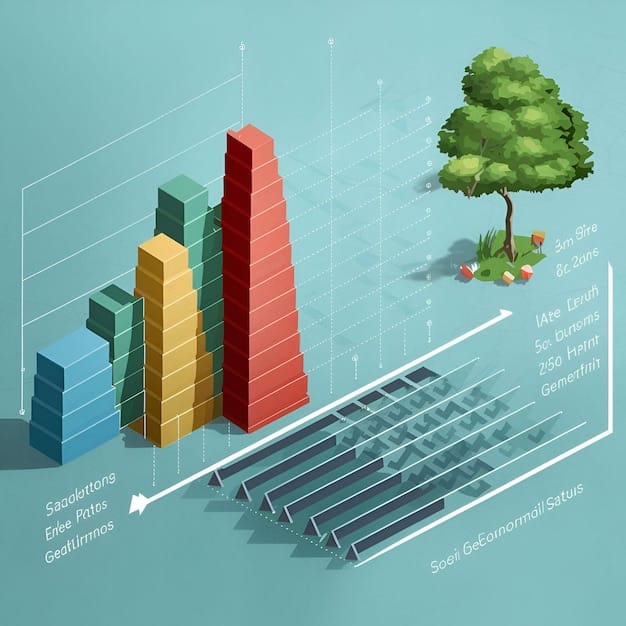US Climate Risk Disclosure Rule: Investor Impact Explained

The new US Climate Risk Disclosure Rule mandates companies to report climate-related risks, offering investors enhanced transparency and data for informed decision-making.
The financial landscape is evolving, with environmental concerns playing an increasingly pivotal role. A significant development in this arena is the new US Climate Risk Disclosure Rule, poised to reshape how investors assess and manage climate-related risks and opportunities.
Understanding the Climate Risk Disclosure Rule
The genesis and core principles of the Climate Risk Disclosure Rule are essential for understanding its impact. This rule, championed by regulatory bodies, aims to standardize and enhance the reporting of climate-related risks by publicly traded companies. It’s designed to address the growing demand from investors for clearer, more reliable environmental data.
The framework that dictates the need and ambition for the Climate Risk Disclosure Rule stems from the increasing awareness of climate change affecting business operations and investment portfolios. With this rule, firms operating in the United States will need to provide extensive disclosures on greenhouse gas emissions, the risks climate alterations place on strategy, business model, and outlook, and the governance processes for identifying risks connected to this alteration.
Key Elements of the Rule
The key components of the Climate Risk Disclosure Rule circle around transparency and comparability. Companies are going to be mandated to report both direct and indirect greenhouse gas emissions, a scope 1 and scope 2 and, in certain cases, scope 3 emissions. Also, they will have to demonstrate how climate related risks are identified and managed.
Goals of the Disclosure Rule
The end goals with the unveiling of these disclosures include enhancing investors’ awareness of risks connected to climate. Also, this is supposed to provide additional data that will enable better resource allocations that will align with the objectives of sustainability. Furthermore, by standardising climate reporting, the disclosure rule assures that all industry participants are held on fair and uniform levels to permit easier comparisons.
- Enhances investor transparency regarding climate-related financial risks.
- Provides standardized metrics for comparing companies’ environmental impacts.
- Encourages firms to integrate climate risk management into their core strategies.
In conclusion, the Climate Risk Disclosure Rule is a move towards more transparent and sustainable financial markets. By mandating standardised climate risk disclosures, the rule empowers investors with the knowledge needed to make informed decisions, driving capital towards sustainable and responsible investments.
How the Rule Affects Different Sectors
The Climate Risk Disclosure Rule’s effects differ depending on the kind of business industry. Certain sectors will face more intense scrutiny and reporting mandates given their greater environmental exposure. Understanding these distinctions will allow for better-informed investment strategies.
Industries like energy, transportation, and manufacturing, which typically have high carbon footprints, are expected to be prominently influenced. These sectors may face greater demands to lower emissions as well as adapt to sustainable business models. Businesses in this area may also have to assess as well as report the effect of climate related regulations.
Financial Services and Climate Risk
On the other hand, financial services sector faces indirect consequences. Banks, insurance firms, and investment funds will have to incorporate climate risks when they are assessing their investments and lending decisions.
Technology and Climate Disclosure
The technology sector is another place to see considerable movement. Tech firms are likely to have an important part in supplying solutions to track as well as report climate related information. In the meantime, software, hardware and data management will assist other sectors in complying with the new disclosure needs.

- High-carbon sectors (energy, transportation) may face stricter emissions mandates.
- Financial services will integrate climate risks into investment decisions.
- Technology sectors may innovate in climate data tracking and reporting.
In conclusion, the Climate Risk Disclosure Rule initiates the integration of environmental considerations into all sectors. This change provides both opportunities and challenges for innovation and sustainability.
What Information Companies Must Disclose
The need for robust disclosure standards is core to the success of the Climate Risk Disclosure Rule. Comprehending the key revelation metrics makes it well-disposed to interpret the effect and compliance specifications of the rule.
The disclosure’s key elements will have detailed reporting in the greenhouse gas emissions that includes scope 1, which are direct emissions from business-owned or controlled sources; scope 2, which cover indirect emissions from the generation of purchased electricity; and in certain situations, scope 3 emissions, which include all the indirect emissions that occur in the supply chain.
Scenario Planning and Climate Risks
Also, businesses will have to demonstrate their climate risk exposure and the way these risks can impact the business strategy, operations and economic outlooks. This usually calls for setting up scenario plans that analyze how various climate situations could change their business.
Financial Footprints
Additionally, the financial influence of climate connected events like floods, storms, together with the transition hazards through policy or tech changes must be shown clearly. Investors require this information to grasp possible financial weakness because of climate change as well as the costs of complying with green requirements.
In conclusion, companies’ environmental reporting will affect their financial prospects significantly. Clear reporting will bolster investor confidence and encourage market transparency.
The Benefits of Climate Risk Disclosure for Investors
The Climate Risk Disclosure Rule gives a trove of advantages for investors. By enhancing the accessibility of information about climate risks, the rule makes it possible for investors to make more knowledgeable choices as well as to promote sustainable business practices.
The disclosure of risks allows investors to assess the possible monetary vulnerabilities of companies that can be associated with climate change. For instance, businesses that do not properly handle climate hazards can be subject to considerable financial loss as a result of regulatory fines, operational disruptions, or damage to the company’s reputation.
Improved Investment Strategies through Climate Risk Disclosure
Additionally, the standardization of revealing environmental data enables investors to make direct comparisons across companies within sector. This eases spotting leaders in sustainability as well as those who lag, by directing investment to more eco-friendly companies.
Sustainable Investment Surge
Furthermore, the push towards more transparency strengthens accountability in company environmental performance by increasing transparency as well as accountability. Investors could better see when companies are sticking with their environmental commitments, and they could punish the underperformers.

- Enables investors to assess companies’ financial vulnerability to climate change.
- Enhances ease of comparison across companies in environmental performance.
- Encourages corporate accountability and transparency in climate impact.
In conclusion, the Climate Risk Disclosure Rule empowers investors. This results in smarter investment choices and supports global sustainability goals.
Challenges and Criticisms of the Rule
Despite the many advantages from the Climate Risk Disclosure Rule, challenges and criticism have emerged. It’s crucial to grasp these to completely figure out the way the rule is carried out and its final efficiency.
A primary concern revolves around the cost and intricacy involved in complying with the new revelation requirements. Smaller businesses, especially, can be challenged to handle considerable reporting burdens, leading to competitive disadvantages.
Data Reliability and Interpretation
Still another criticism deals with the trustworthiness and standardization of climate. Making sure that companies utilize reliable methods to determine and report their emissions is critical, so too is how different investors understand these data.
Disclosure Scope
Also disputes emerge as to what degree must these businesses reveal. The decision to incorporate scope 3 emissions, that require assessment of environmental effects of its whole value chain, is especially controversial due to the troubles in precise accounting.
In conclusion, addressing these criticisms and difficulties is important to maximize the advantages from the Climate Risk Disclosure Rule and its viable application.
Future Implications for the Investment World
It is very likely that the execution of this Climate Risk Disclosure Rule could affect the wider investment ecosystem. In the long run, we will be able to see changes in the way that companies operate, as well as invest, and how risk will assessed.
Investors that make sustainable finance a priority in their investments can be able to see considerable growth. Investors will likely look to bring capital into organizations known as eco-friendly or that are actively decreasing their footprints.
Long-Term Financial Market Impacts
Also, the financial market may evolve to price climate relating risks more effectively. This could lead to higher cost of capital to businesses prone to climate risks and lower rates to those preparing effectively.
Innovation and Adaptation Driven by Climate Disclosure
Lastly, as companies adapt to the new norms, this may spark innovation to come up with climate risk mitigation. This can result in fresh opportunities for expansion as well as opportunities for investments in technologies and environmentally friendly processes.
| Key Aspect | Brief Description |
|---|---|
| 🌱 Reporting Mandates | Mandatory disclosure of greenhouse gas emissions and climate risks. |
| 📊 Investor Benefits | Enhanced transparency allows for informed and sustainable investment decisions. |
| 🌐 Sector Impact | Varying effects on energy, finance, tech sectors, and more. |
| ⚠️ Challenges | Compliance costs and data reliability issues. |
Frequently Asked Questions
▼
The rule primarily aims to increase transparency by requiring companies to report climate-related risks, enabling investors to make informed decisions.
▼
Small businesses may face challenges due to the costs and complexity of compliance, potentially creating a competitive disadvantage.
▼
Companies must report scope 1 (direct) and scope 2 (indirect) greenhouse gas emissions. Scope 3 emissions may also be required.
▼
Investors can assess financial vulnerabilities related to climate change, compare companies, and promote accountability in corporate environmental performance.
▼
The rule may drive growth in sustainable finance, price climate risks more effectively, and spur innovation in climate risk mitigation technologies.
Conclusion
The introduction of the US Climate Risk Disclosure Rule marks a pivotal shift towards integrating climate considerations into financial decision-making. While challenges exist, the potential benefits for investors—greater transparency, better risk assessment, and the promotion of sustainable practices—are substantial, setting a new course for the investment world.





